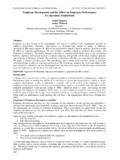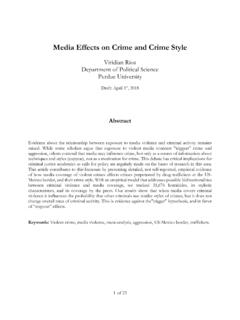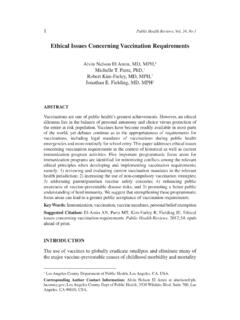Transcription of IDEA: Ethical Decision-Making Framework
1 IDEA: Ethical Decision-Making Framework The R egional Ethics Program is an ethics service based on a hub and spoke model. The hub is Trillium Health Partners and spokes include organizations in the region that purchase services from the Regional Ethics Program. The IDEA: Ethical Decision-Making Framework was modified by the Regional Ethics Program and builds upon the Toronto Central Community Care Access Centre Community Ethics Toolkit (2008), which was based on the work of Jonsen, Seigler, & Winslade (2002); the work of the Cor e C urriculum Working Group at the University of Toronto Joint Centre for Bioethics; and incorporates aspects of the accountability for reasonableness Framework developed by Daniels and Sabin (2002) and adapted by Gibson, Martin, & Singer (2005).
2 Regional Ethics Program August 2013 Framework - 2 Introduction Ethics is about making right or good choices and the reasons that we give for our choices and actions. Ethics promotes reflective practice in the delivery of health care. Ethics addresses the question What should we do and why? Another way to describe ethics is as follows. It is about: Deciding what we should do what decisions are morally right or acceptable; Explaining why we should do it justifying our decision using language of values and principles; and Describing how we should do it outlining an appropriate process for enacting the Ethical issues arise every day in health care (See Appendix A).
3 Everyone has a role to play in ensuring the Ethical delivery of care, from bedside to boardroom. Ethical principles and values are incorporated into the way that decisions are made and care is delivered every day. Accreditation Canada expects that healthcare organizations will have in place a Framework for guiding Ethical behavior that is publicly accessible and consistent with the law. As healthcare organizations seek to provide quality care in the face of significant financial constraints, they face difficult decisions. Both technical ( , cost-effectiveness analyses) and principle-based solutions ( , distributive justice ) alone are limited in their ability to resolve priority-setting challenges (Gibson, Martin, & Singer, 2005).
4 Given that there may be competing goals and values, ensuring procedural fairness may be the best way to ensure that decisions are socially accepted and demonstrate public accountability (Gibson et al., 2005). The purpose of the IDEA: Ethical Decision-Making Framework (see Figure 1) is to provide a step-by-step, fair process to help guide healthcare providers and administrators in working through Ethical issues encountered in the delivery of healthcare. The Framework can be used to guide Decision-Making and actions about Ethical issues that arise from the bedside to the boardroom. The Framework addresses two general types of Ethical decisions that lie across a continuum: clinical and organizational. Clinical Ethical decisions are typically those that involve and impact specific individuals or staff members and focus on individual values ( , Should Mr.)
5 B s life-sustaining treatment be discontinued?). Organizational Ethical decisions are generally those that involve and impact groups of patients/clients/residents or staff members, units, systems, or the organization as a whole and centre on the values of the organization ( , Should the maternal-child program be expanded, reduced, or remain unchanged?). Some Ethical decisions may be predominantly clinical in nature; others will be largely organizationally focused. A number of Ethical decisions will have both clinical and organizational aspects. Use of the Framework can help an individual, team or community to work through an Ethical issue. It can help a team or community work together by introducing a shared systematic process, facilitating effective communication, developing a shared language and building a common understanding of how to approach difficult Ethical issues.
6 1 Definition adapted from Dr. Barbara Secker, Joint Centre for Bioethics, University of Toronto. Regional Ethics Program August 2013 Framework - 3 The IDEA: Ethical Decision-Making Framework is comprised of four steps and incorporates five conditions identified as important in the accountability for reasonableness Framework developed by Daniels and Sabin (2002) and adapted by Gibson, Martin, and Singer (2005). The first letter of each step in this Framework forms the acronym IDEA. In the centre of the Framework there is a light-bulb (a further reference to the Framework s acronym, IDEA).
7 The light-bulb contains a set of questions to assist healthcare providers/administrators in the identification of Ethical issues to which the Framework can be applied. The Framework is depicted as circular, suggesting that decisions need to be revisited as new facts emerge. The four steps are: 1. Identify the facts. 2. Determine the relevant Ethical principles. 3. Explore the options. 4. Act. The five conditions are: Empowerment: There should be efforts to minimize power differences in the Decision-Making context and to optimize effective opportunities for participation (Gibson et al., 2005). Publicity: The Framework (process), decisions and their rationales should be transparent and accessible to the relevant public/stakeholders (Daniels & Sabin, 2002).
8 Relevance: Decisions should be made on the basis of reasons ( , evidence, principles, arguments) that fair-minded people can agree are relevant under the circumstances (Daniels & Sabin, 2002). Revisions and Appeals: There should be opportunities to revisit and revise decisions in light of further evidence or arguments. There should be a mechanism for challenge and dispute resolution (Daniels & Sabin, 2002). Compliance (Enforcement): There should be either voluntary or public regulation of the process to ensure that the other four conditions are met (Daniels & Sabin, 2002). Regional Ethics Program August 2013 Framework - 4 Figure 1 IDEA: Ethical Decision-Making Framework 1 The IDEA: Ethical Decision-Making Framework builds upon the Toronto Central Community Care Access Centre Community Ethics Toolkit (2008), which was based on the work of Jonsen, Seigler, & Winslade (2002); the work of the Core Curriculum Working Group at the University of Toronto Joint Centre for Bioethics; and incorporates aspects of the accountability for reasonableness Framework developed by Daniels and Sabin (2002) and adapted by Gibson, Martin, & Singer (2005).
9 1. Identify the Facts. Clinical/Medical Indications Individual Preferences Evidence Contextual Features Ask: What is the Ethical issue? 2. Determine the Relevant Ethical Principles. Nature & Scope Relative Weights Ask: Have perspectives of relevant individuals been sought? 3. Explore the Options. Harms & Benefits Strengths & Limitations Laws & Policies Mission, Vision, Values Ask: What is the most ethically justifiable option? 4. Act. Recommend Implement Evaluate Ask: Are we (am I) comfortable with this decision ? PUBLICITY RELEVANCE COMPLIANCE EMPOWERMENT REVISIONS & APPEALS What is an Ethical issue? Am I trying to determine the right course of action?
10 Am I asking a should question? Are values and beliefs involved? Am I feeling uncomfortable? If you answered yes to any of these questions, you may be encountering an Ethical issue. Regional Ethics Program August 2013 Framework - 5 Step by Step Guidelines For each step in the Framework , a number of guiding questions and/or considerations and an overarching question are posed. Some of the questions may be more relevant for clinical decisions; others for organizational decisions. In addition the conditions that should be met during each step of the process are described. At any point in the process, you can seek the assistance of an ethicist, ethics facilitator, ethics forum, or other professionals to help work through the process and resolve any areas of contention.




